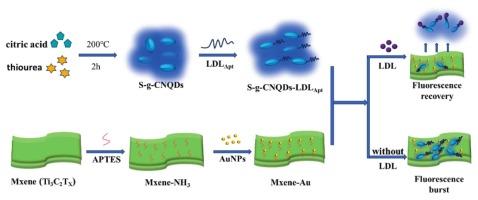硫掺杂氮化碳量子点与MXene-Gold纳米复合材料集成的超灵敏低密度脂蛋白检测用fret驱动荧光适体传感器
IF 4.6
2区 化学
Q1 SPECTROSCOPY
Spectrochimica Acta Part A: Molecular and Biomolecular Spectroscopy
Pub Date : 2025-09-20
DOI:10.1016/j.saa.2025.126970
引用次数: 0
摘要
低密度脂蛋白(LDL)是心血管疾病(CVD)风险评估的重要生物标志物。准确、灵敏地监测人血清LDL水平对于及时诊断、有针对性的干预和降低死亡率至关重要。本文基于荧光共振能量转移(FRET)原理,以掺杂硫的与LDL适配体共轭的石墨氮化碳量子点(S-g-CNQDs-LDLApt)为荧光供体,mxene负载的金纳米粒子(MXene-Au)为能量受体,构建了用于LDL检测的荧光适配体传感器。传感机制依赖于低密度脂蛋白浓度依赖性荧光恢复介导的FRET破坏。在最佳条件下,荧光适体传感器线性动态范围为20.0 ~ 100.0 μg/mL(回归方程:Y = 0.00874× - 0.07426, R2 = 0.9900),检出限(LOD)为0.343 μg/mL。在临床血清样本中,相对标准偏差(RSD)范围为0.48%至2.64%,证实了传感器在生物基质中LDL分析的可靠性。提出的生物传感器在临床血清分析中显示出巨大的潜力,为即时心血管疾病风险分层提供了一种新的范例。本文章由计算机程序翻译,如有差异,请以英文原文为准。

FRET-driven fluorescent aptasensor for ultrasensitive low-density lipoprotein detection integration of sulfur-doped carbon nitride quantum dots and MXene-Gold nanocomposites
Low-density lipoprotein (LDL) is a critical biomarker for cardiovascular disease (CVD) risk assessment. Accurate and sensitive monitoring of LDL levels in human serum is crucial for timely diagnosis, targeted intervention, and reduction of mortality. In this paper, we constructed a fluorescent aptamer sensor for LDL determination based on sulfur-doped graphitic carbon nitride quantum dots conjugated with LDL aptamer (S-g-CNQDs-LDLApt) as a fluorescence donor and MXene-supported gold nanoparticles (MXene-Au) as the energy acceptor, based on fluorescence resonance energy transfer (FRET) principle. The sensing mechanism relies on LDL concentration-dependent fluorescence recovery mediated by the disruption of FRET. Under optimal conditions, the fluorescent aptamer sensor exhibited a linear dynamic range of 20.0–100.0 μg/mL (regression equation: Y = 0.00874× – 0.07426, R2 = 0.9900), with a detection limit (LOD) of 0.343 μg/mL. In clinical serum samples, the relative standard deviations (RSD) ranged from 0.48 % to 2.64 %, confirming the sensor's reliability for LDL analysis in biological matrices. The proposed biosensor demonstrates great potential for clinical serum analysis, offering a novel paradigm for point-of-care CVD risk stratification.
求助全文
通过发布文献求助,成功后即可免费获取论文全文。
去求助
来源期刊
CiteScore
8.40
自引率
11.40%
发文量
1364
审稿时长
40 days
期刊介绍:
Spectrochimica Acta, Part A: Molecular and Biomolecular Spectroscopy (SAA) is an interdisciplinary journal which spans from basic to applied aspects of optical spectroscopy in chemistry, medicine, biology, and materials science.
The journal publishes original scientific papers that feature high-quality spectroscopic data and analysis. From the broad range of optical spectroscopies, the emphasis is on electronic, vibrational or rotational spectra of molecules, rather than on spectroscopy based on magnetic moments.
Criteria for publication in SAA are novelty, uniqueness, and outstanding quality. Routine applications of spectroscopic techniques and computational methods are not appropriate.
Topics of particular interest of Spectrochimica Acta Part A include, but are not limited to:
Spectroscopy and dynamics of bioanalytical, biomedical, environmental, and atmospheric sciences,
Novel experimental techniques or instrumentation for molecular spectroscopy,
Novel theoretical and computational methods,
Novel applications in photochemistry and photobiology,
Novel interpretational approaches as well as advances in data analysis based on electronic or vibrational spectroscopy.

 求助内容:
求助内容: 应助结果提醒方式:
应助结果提醒方式:


